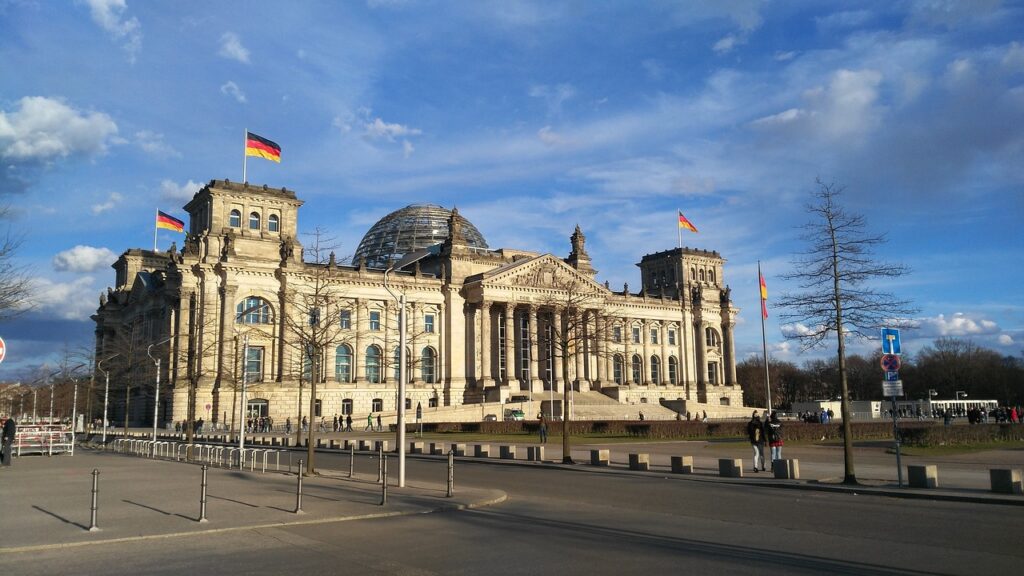Germany, historically the bedrock of European economic stability, is now at the center of a storm. Once renowned for its industrial strength and fiscal prudence, the German economy is grappling with stagnation, geopolitical risks, and structural challenges. These struggles reverberate across Europe, threatening regional cohesion and global influence. This detailed news article examines Germany’s economic turmoil, its broader implications for Europe, and potential paths forward.

Germany’s Economic Woes: An Analysis
Stagnation Takes Root
The German economy has been in a state of near-stagnation since late 2019. Projections for 2025 paint a bleak picture:
- Goldman Sachs: GDP growth of 0.3%.
- Bundesbank: GDP growth of 0.2%.
- Kiel Institute: Complete stagnation at 0.0%.
The contributing factors include:
- Export Weakness: Declining demand, particularly from China, has hurt Germany’s export-driven economy.
- Consumption Challenges: Rising inflation and sluggish wage growth have curbed consumer spending.
- Investment Gaps: Uncertainty around fiscal and political direction has deterred both public and private investment.
The long-term consequences of this stagnation are profound, threatening Germany’s position as Europe’s economic leader and eroding confidence in its ability to recover.
Political Instability and Fiscal Constraints
Germany’s early federal elections in February 2025 add to the uncertainty. Investors and analysts are closely monitoring two key issues:
- Fiscal Strategy: Despite its low debt-to-GDP ratio, Germany’s “debt brake” restricts borrowing, limiting the government’s ability to fund growth-stimulating initiatives.
- Election Outcomes: The formation of a cohesive government capable of implementing reforms is critical to restoring confidence and unlocking investments.
The Kiel Institute warns that delays in addressing fiscal challenges are already affecting business sentiment and delaying critical investments.
Automotive Industry at Risk
The German automotive sector, once a symbol of industrial dominance, is facing a crisis:
- EV Transition Challenges: German automakers lag behind US and Chinese competitors in electric vehicles (EVs).
- Energy Costs: Elevated energy prices are squeezing profits and reducing the industry’s global competitiveness.
- Shifting Trade Dynamics: Reduced Chinese demand for German automobiles underscores the sector’s vulnerabilities.
These structural issues threaten the industry’s ability to remain a key driver of Germany’s economy.
Geopolitical and Trade Risks
Global protectionism is an ongoing threat to Germany’s export-driven model. The anticipated trade policies of the incoming Trump administration could impose new tariffs on EU goods, potentially reducing Germany’s GDP by up to 1.2%, according to the Kiel Institute. Persistent uncertainty around global trade is already dampening business confidence.
Energy Crisis and Inflation
The energy problems have a major effect on the German economy and continue to be a significant obstacle to economic growth:
- Industrial Declines: Energy-intensive industries have contracted by up to 15% due to high costs.
- Inflationary Pressures: Inflation is projected to ease slightly but will remain elevated at 2.4% in 2025.
Germany’s phase-out of nuclear energy has left it dependent on costlier alternatives, further exacerbating the crisis.
Ripple Effects Across Europe
Economic Contagion
As Europe’s largest economy, Germany’s struggles are deeply felt across the continent. Weak demand from Germany reduces export opportunities for neighboring countries, amplifying economic disparities within the EU.
Political Instability
Economic challenges are fueling political volatility across Europe. The rise of far-right parties in several nations mirrors the growing dissatisfaction with traditional governance models.
Energy Vulnerabilities
Germany’s energy crisis highlights broader European challenges. Coordinated efforts to transition to renewable energy and reduce dependence on imports are urgently needed.
Competitiveness Concerns
The systemic issues affecting Germany’s industrial competitiveness reflect broader weaknesses in Europe’s ability to innovate and compete globally.
German Economy Predictions and Expert Opinions
Short-Term Outlook (2025)
- Economic Growth: Near-zero growth is likely, with risks of contraction if external shocks materialize.
- Political Stability: The February 2025 elections will be critical. A fragmented coalition could exacerbate uncertainties, while a decisive mandate could pave the way for reforms.
Medium-Term Outlook (2025-2030)
- Reform Imperative: Structural reforms in taxation, labor, and infrastructure are essential to reviving growth.
- Energy Transition: Accelerating renewable energy adoption is key to stabilizing energy costs and supporting industrial recovery.
Experts like Professor Timo Wollmershäuser of the IFo Institute warn: “Without bold policy interventions, Germany’s stagnation risks becoming a permanent condition.”
Recommendations
For Germany:
- Relax Fiscal Restrictions: Leverage fiscal capacity to fund strategic investments.
- Support Key Industries: Incentivize innovation in sectors like automotive and green technology.
- Expand Workforce Policies: Address labor shortages through immigration and training programs.
For Europe:
- Coordinate Energy Policies: Invest in cross-border infrastructure to lower costs and enhance resilience.
- Defend Trade Interests: Develop unified strategies to counter protectionist measures.
- Promote Regional Cohesion: Address economic disparities to strengthen EU stability.
Wrapping up
Germany’s economic challenges are a stark reminder of the vulnerabilities facing even the most robust economies. The nation’s struggles, intertwined with broader European issues, require urgent and coordinated action. While the road ahead is fraught with challenges, decisive reforms and strategic investments could reinvigorate Germany’s economy and secure its role as a cornerstone of European stability and prosperity.




